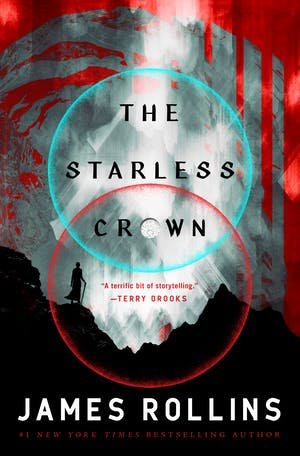The Starless Crown by James Rollins
/The Starless Crown
By James Rollins
Tor, 2022
Longtime fans of James Rollins will remember his first forays into the writing of high fantasy, well over a decade ago: the “Banned and the Banished” series and the “Godslayer” books, written under the name James Clemens, were classic examples of the genre and might have hinted at a long future career mining that vein. But alongside some of those early novels were creatures of a very different sort: big, sprawling airport thrillers like Excavation, Ice Hunt, and especially his terrific 2002 Amazonia. There’s been a profusion of novels in the intervening fifteen years, but this new book by Rollins, The Starless Crown (rumored to be the first in a series called “Moon Fall”), marks his at-long-last return to the genre that launched his career.
It’s a dutifully full-dress thing, dedicated to Terry Brooks and sporting a cover blurb by him. It’s over 500 pages long; it’s got a map; it assembles a varied fellowship; it brims with lore; it serves up a series of MacGuffins (including one on the very last page); it promises sequels. And it raises questions.
The plot mostly centers on a fourteen-year-old girl named Nyx, a foundling at a cloistered academy on a world which is half in sunlight and half in darkness all the time (but tilted on its axis, so there are habitable zones for humans at the poles). When the novel opens, Nyx is laboring under two afflictions: she’s nearly blind, with misty, clouded sight, and she’s having visions that feature giant, vicious Myr bats (the book’s most consistently scene-stealing invention) and that could mean the impending end of the world.
She quickly gets some unexpected confirmation of those visions: she learns from an “alchymist” named Frell that observations of the moon show it growing in size – including ominous recent rapid growth. “Moon fall” Nyx whispers in awe.
The narrative opens to tell other stories, particularly that of a young thief named Rhaif who escapes in a very unusual way from his hopeless toil in a chalk mine, and Prince Kanthe, a “Prince in the Cupboard” whose brother Prince Mikaen is politically destined to inherit the throne and rhetorically destined to become a snide, scenery-chewing villain. The point-of-view shifts are smoothly, convincingly done, and all the tricks Rollins learned from years of writing thrillers keep the plot moving briskly along even in what very much feels like a ground-clearing first volume.
But that brings up the questions again, the foremost being: is this a triumphant return or a quasi-pastiche, or a bit of both? There’s certainly an uneven quality to the narrative tone, which runs from slangy thriller-speak (“There’s a first time for everything” quipped with sarcastic abandon, “Let’s do this” quipped before an action sequence, etc.) to almost a parody of the cod-medieval lingo that was bird-imprinted on the entire genre by JRR Tolkien: “countenance” instead of “face,” “atop” instead of “on,” “I would speak with you” instead of “let’s talk,” and, deadliest of all, “mayhap.”
Or could it be that none of this is really uneven at all? Could the contrast of dialogue styles be an intentional gambit to shake up the conventions so honored by Terry Brooks and company? Could all those familiar archetypes be clubbed together here in order to produce a comfortingly welcoming atmosphere for genre junkies, just like all the exotic locations and central-casting jet-set scientists in those airport thrillers? Could the book’s fairly flat narrative arc be designed to hook readers for an assembly-line of future volumes?
Mayhap, dear reader. Mayhap.
Steve Donoghue is a founding editor of Open Letters Monthly. His book criticism has appeared in The Washington Post, The American Conservative, The Spectator, The Wall Street Journal, The National, and the Daily Star. He writes regularly for The Boston Globe, the Vineyard Gazette, and the Christian Science Monitor. He’s a books columnist for the Bedford Times Press and the Books editor of Big Canoe News in Georgia, and his website is http://www.stevedonoghue.com.
